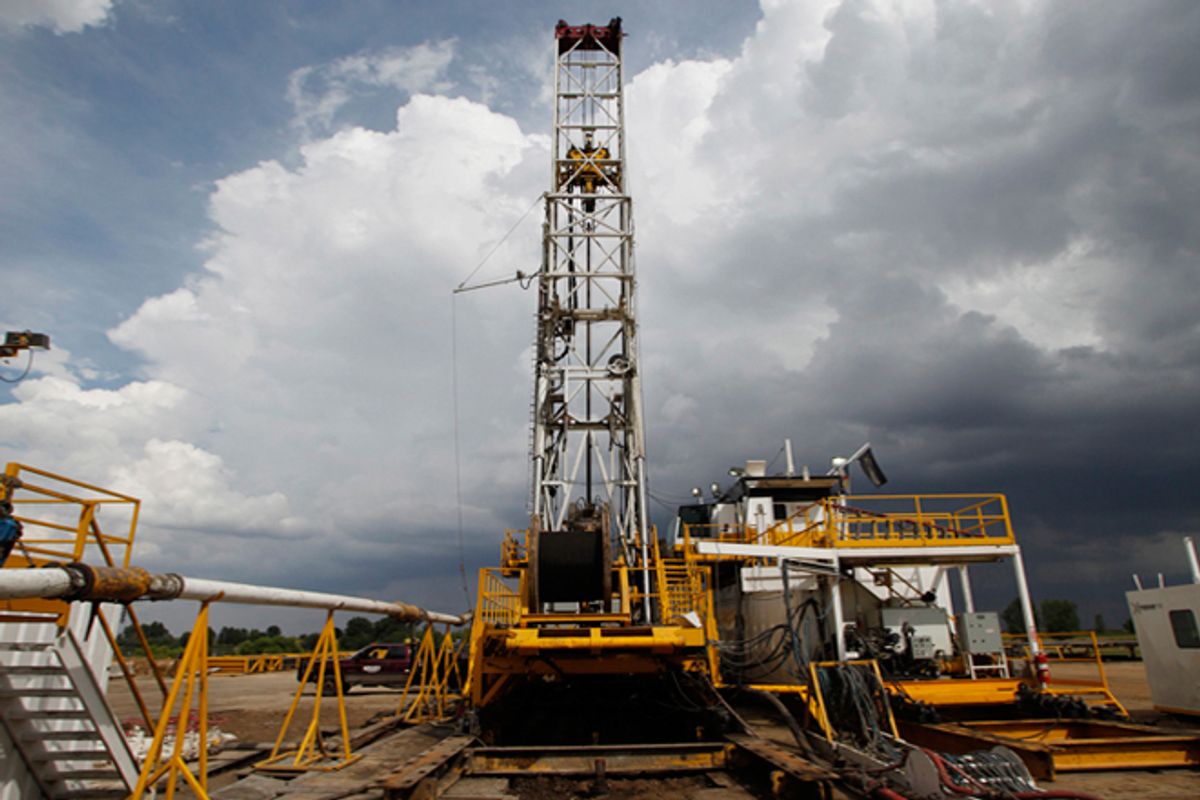 The battle over hydraulic fracking of oil and natural gas has pitted land owners against each other. It has also created divides between neighboring states such as Pennsylvania, Ohio and New York. And now, after the Environmental Defense Fund joined a coalition of nonprofits and oil companies called the Center for Sustainable Shale Development, fracking is also splitting the environmental community.
The battle over hydraulic fracking of oil and natural gas has pitted land owners against each other. It has also created divides between neighboring states such as Pennsylvania, Ohio and New York. And now, after the Environmental Defense Fund joined a coalition of nonprofits and oil companies called the Center for Sustainable Shale Development, fracking is also splitting the environmental community.
The Center for Shale Development advocates that oil and gas companies voluntarily adopt 15 performance standards. These cover wastewater disposal, fracking fluids, air pollution standards for drill engines, limits on gas flaring in the fields and more. But this week, 68 grassroots groups protested the Environmental Defense Fund’s move, arguing the big environmental advocacy organization had allowed itself to be “co-opted by industry interests,” and that it was engaged in “greenwashing.”
In a recent story for this magazine, I wrote about how the debate over fracking is a false dilemma; that until we regulate and tax the practice, all of the environmental and economic burdens will continue to fall on the people who live above the wells.
To be sure, the potential for damage from fracking is something to take seriously, but after 60 years of using the technique in hundreds of thousands of wells, there are relatively few cases of groundwater contamination. So few that the EPA’s recent determination that Wyoming groundwater was affected by fracking stands out. A study in Pennsylvania affirms that methane appears to migrate into drinking aquifers — likely because of poor cement seals around well pipes. Though the industry has best practices for the seals, following them is voluntary in some states. I am not trying to imply that fracking is safe, but that its danger depends upon local geology, the competence of the drillers themselves, and — above all — effective regulation.
Which is an environmental issue we should be talking about. Effective regulation can reduce risky practices and encourage drillers to compete on safety rather than costs. Consider the oil tanker: Thanks to legislation introduced after the Exxon Valdez disaster, we have dramatically reduced both the number and size of tanker spills. Anytime a tanker is loaded with oil, it runs the risk of a spill, but our high-energy lifestyle depends on our willingness to accept — and manage — these risks. And so tankers and barges now need to carry insurance for unlimited damages from an oil spill. Insurers, who have money on the line, have enforced best practices, which have reduced spills considerably. Yet for the moment, the regulation of fracking is progressing state by state, without the unified routine that was taken with transporters. At the federal level, meanwhile, there have been setbacks: The 2005 energy bill, for instance, exempted gas drillers from parts of federal clean water regulations.
…
Well-regulated, fracked natural gas could be a plus for the environment — particularly if it were coupled with a ban on coal. The extraction of coal via mountaintop removal is extraordinarily damaging to the environment. Power plants that burn coal emit more radiation into neighborhoods around them than do nuclear power plants, and fine particle pollution from coal-powered plants costs 13,000 lives a year, while producing an enormous quantity of greenhouse gas emissions. Coal, arguably, really does equal death. Fracking is not pretty, but there is more than one principled environmental conversation to have about it.
Mark Brownstein, at the Environmental Defense Fund, wrote on the organization’s blog that the 15 voluntary standards proposed (by the Center for Sustainable Shale Development) need to go further. That’s certainly true; the list doesn’t deal with abandoned wells, for starters. Nor are voluntary practices any replacement for regulation and enforcement, but they are at least a step toward consensus and national regulation. (I’d love to see a tax included, too.) In some states, fracking is a Wild West, where anything goes and even following best practices is voluntary; that is simply grotesque and unfair. Through the Center for Sustainable Shale Development, Chevron, Shell, Consol Energy and EQT Corporation have agreed to some self-policing. The holdings of these companies cover about eight million acres — not a small amount of land. The two smaller companies alone have 27,000 wells between them. No one wants to have one of those wells in their backyard, but wouldn’t you want the company that owns them to follow some rules, rather than none?



Shares